Dissertation
My research takes place at the Lac Télé Community Reserve in the Republic of Congo. This protected area is a part of the worlds largest tropical peat swamp forest expanse, is home to one of the densest-known populations of western lowland gorillas as well as other endangered megafauna like chimpanzees and forest elephants, and is currently the Republic of Congo’s only designated community reserve, home to over 20,000 forest dependent people.
My project uses three different methods to examine the complex interactions between Lac Télé’s apes, elephants, and people, as well as how these interactions are mediated by widespread seasonal flooding which set the site apart from other sites where great apes are currently studied. Want more detail? Explore more about my research below using the links below.
Research Team
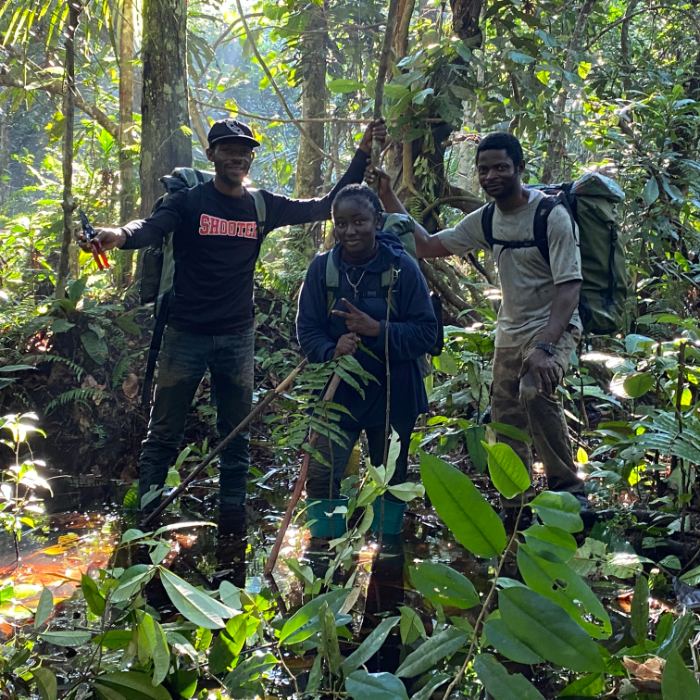 Many people are integral to the on-the-ground success of my project. I currently collaborate with two Congolese PhD students as well as local staff and communities at Lac Télé.
Many people are integral to the on-the-ground success of my project. I currently collaborate with two Congolese PhD students as well as local staff and communities at Lac Télé.
I manage an active GoFundMe page raising money to help offset the costs for my team members to visit the US once our fieldwork is complete. Help me remedy the inequalitites in opportunity and privelege which characterize academic and scientific research practices and consider DONATING!
Research Origins
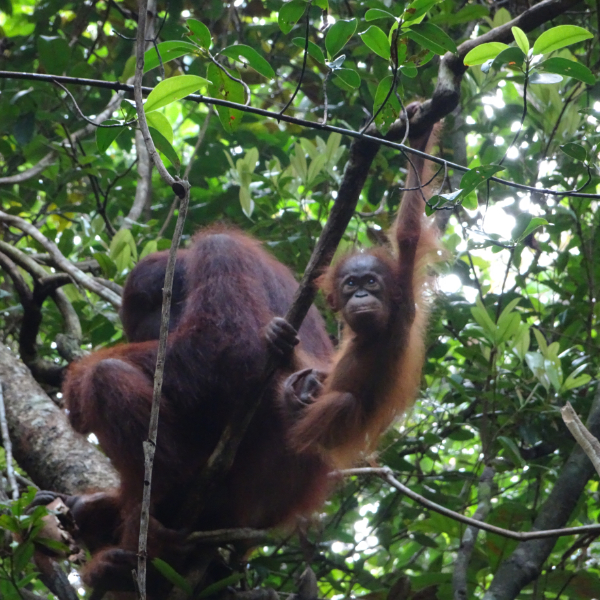 I grew up interested in wildlife ecology but never pursued it academically until I was in undergrad at Macalester College. Discovering the world of primatology hidden within the subfield of biological anthropology, I found that primate research existed at a theoretical crossroads between quantitative and qualitative study and thus, fit my interests perfectly. Having the oportunity to travel abroad and conduct a self-designed study on lemur habituation in Madagascar, I began my foray into the world of field primatology. Following graduation, I was hired as a research assistant at the Tuanan Orangutan Research Station, helping collect long-term data the behavioral ecology of bornean orangutans livinging in a peat swamp forest in Central Kalimantan. During my year at Tuanan, I learned a lot about different kinds of behavioral and ecological data collection, the joys and rigors of remote fieldwork, the value of intercultural exchange and scientific outreach, and, most importantly, the state of great ape and tropical peatland conservation. Further, I saw clearly the link between qualitative, socio-cultural research and successful conservation as well as the stark absence of any such inquiry from most primate ecology.
I grew up interested in wildlife ecology but never pursued it academically until I was in undergrad at Macalester College. Discovering the world of primatology hidden within the subfield of biological anthropology, I found that primate research existed at a theoretical crossroads between quantitative and qualitative study and thus, fit my interests perfectly. Having the oportunity to travel abroad and conduct a self-designed study on lemur habituation in Madagascar, I began my foray into the world of field primatology. Following graduation, I was hired as a research assistant at the Tuanan Orangutan Research Station, helping collect long-term data the behavioral ecology of bornean orangutans livinging in a peat swamp forest in Central Kalimantan. During my year at Tuanan, I learned a lot about different kinds of behavioral and ecological data collection, the joys and rigors of remote fieldwork, the value of intercultural exchange and scientific outreach, and, most importantly, the state of great ape and tropical peatland conservation. Further, I saw clearly the link between qualitative, socio-cultural research and successful conservation as well as the stark absence of any such inquiry from most primate ecology.
After deciding to continue on to a PhD, I began searching for a research site that would allow me to take a more interdisciplinary, conservation-focused look at great ape ecology. During this search I discovered the existence of another peat swamp forest – this time in Congo – with two sympatric ape species, people, and a dearth of scientific research to inform conservation management. Though known and protected for its incredibly high densities of western lowland gorillas, Lac Télé is a poorly understood ecosystem; the mechanisms which allow critically endangered species like gorillas, chimpanzees, and forest elephants to coexist with humans and survive seasonal flooding remain highly speculative. When I began considering the feasibility of conducting ape-centered research at Lac Télé, I found myself confronted with an entangled system of cultural and ecological processes – I was unable to ask a simple question about gorilla ecology without evoking more questions about the reserve’s forests, other mammals, and human histories. However, this was precisely the type of system I was searching to study as it is far more representative of the environments in which remaining ape populations exist than are the human-free, national park-based research sites where the majority of primate ecology knowledge is produced (read more about the biases and shortcomings of traditional primate ecology).
Over the course of many years and multiple pilot studies, this project has evolved to be the place-based, interdisciplinary inquiry it is today. The ultimate goals of the project are to advance primatology, anthropology, and wildlife conservation research towards more integrated, complementary frameworks while also contributing essential baseline knowledge on one of the world’s most marginalized and unique ecosystems – a remaining strongholds for great apes, forest elephants, and forest-based ways of life.
Phenology
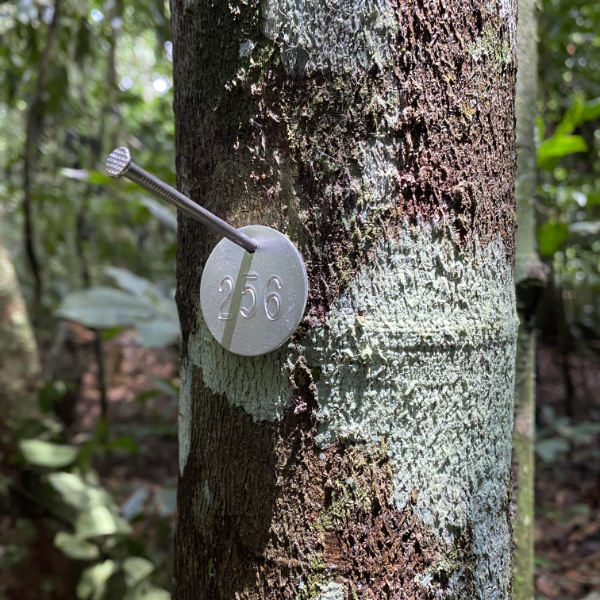 The first component of my project is phenology monitoring. Phenologyis the study of biological cycles. The term is most often used in reference to the study of plant leafing, flowering, and fruiting patterns. Since many primate species are frugivorous or folivorous but have highly flexible diets and live in tropical forests with distinct wet and dry seasons, knowing what is available for an animal to eat and when is very important. For this reason, phenology studies often become the backbone of long-term primate research sites, giving researchers critical insights on the ecology and conservation of a species. Phenology studies also serve as important baselines from which to measure environmental change.
The first component of my project is phenology monitoring. Phenologyis the study of biological cycles. The term is most often used in reference to the study of plant leafing, flowering, and fruiting patterns. Since many primate species are frugivorous or folivorous but have highly flexible diets and live in tropical forests with distinct wet and dry seasons, knowing what is available for an animal to eat and when is very important. For this reason, phenology studies often become the backbone of long-term primate research sites, giving researchers critical insights on the ecology and conservation of a species. Phenology studies also serve as important baselines from which to measure environmental change.
For example, recent papershowed how long-term declines in fruit production in a Gabonese forest has had disasterous consequences for local elephant populations.
For this part of my project, my team and I established transects (straight paths) in four different forest sub-types at Lac Télé:
- Dry forest
- Seasonally-flooded forest
- Hardwood swamp forest
- Raphia swamp forest
With the combined ethnobotanical knowledge of local village elders and the botanical expertise of my team members Bola and Joseph, we tagged 700 trees from over 37 species of known dietary importance for gorillas, chimpanzees, and forest elephants with a unique ID number. Trained teams of local assistants now collect monthly data along these transects, measuring each tagged tree for leaf, flower, and fruit abundance.
Paired with daily recordings of temperature and rainfall near each transect, these data will show us when and where fruits and other resources are available to apes, elephants, and other fruit seekers over the course of a year. Since flooding patterns change monthly and differ between forest types, there is likely to be great spacial and temporal heterogeneity in fruit type, abundance, and accessiblility at Lac Télé.
Lac Télé Forest Heterogeneity: 1. Transect running through an area of marantacea in the dry forest; 2. Tiriel and a local assistant establishing forest plots in hardwood swamp forest; 3. My team walking along our transect in raphia swamp forest.
Dietary Ecology
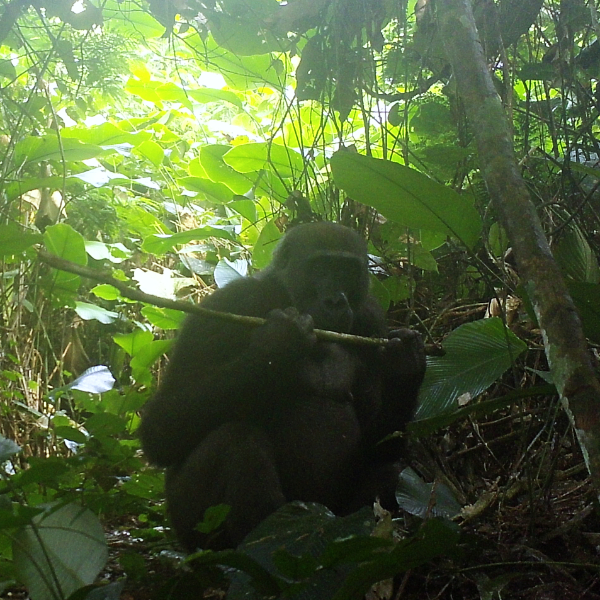 The second component of my project concerns the dietary ecology of apes and elephants at Lac Télé. In primate ecology, once one knows the composition and distribution of food items available to a focal species, the next step is to follow individuals of that species to watch and see what they choose to eat, when. Where sympatric gorillas and chimpanzees have been studied, their partitioning of food resources – particularly of energy-rich ripe fruits – has been a topic of great interest. Those studies show that chimpanzees remain highly frugivorous year round while gorillas – though prefering fruit – shift to a diet of widely available herbs during low fruit periods. This dietary niche partitioning allows these similar species to avoid feeding competition. Gorillas adaptive ability to subsist on herbaceous vegetation has also been used to explain their predilection for open or swampy environments like bais. However, no long-term research has been done on gorillas whose primary habitat is swamp forest.
The second component of my project concerns the dietary ecology of apes and elephants at Lac Télé. In primate ecology, once one knows the composition and distribution of food items available to a focal species, the next step is to follow individuals of that species to watch and see what they choose to eat, when. Where sympatric gorillas and chimpanzees have been studied, their partitioning of food resources – particularly of energy-rich ripe fruits – has been a topic of great interest. Those studies show that chimpanzees remain highly frugivorous year round while gorillas – though prefering fruit – shift to a diet of widely available herbs during low fruit periods. This dietary niche partitioning allows these similar species to avoid feeding competition. Gorillas adaptive ability to subsist on herbaceous vegetation has also been used to explain their predilection for open or swampy environments like bais. However, no long-term research has been done on gorillas whose primary habitat is swamp forest.
Unfortunately, at Lac Télé, there are no ape groups habituated for research purposes, precluding traditional observation methods for assessing diets (as the reserve is not human-free, poaching activities would pose a threat to habituated wildlife). Luckily, there have been great advances in genetic sequencing methods including the emergence of eDNA and DNA Metabarcoding. To nonivasively assess the diets of unhabituated animals, a small amount of fecal material can be collected and sequenced using a primer that identifies species within a certain genetically similar group such as plants, invertebrates, vertebrates, etc. The genetic codes extracted from the sample are compared against existing databases of genetic sequences and matched as closely as possible to generate a list of the dietary components of that sample/animal.
My teams will be collecting fecal samples from chimpanzees, gorillas, and elephants (who have diets similar to those of sympatric great apes – lots of fruit!), for metabarcoding analysis. In the end, these data produced will not only allow us to compare the diets between individuals of each species, but also alow for inter-species comparisons, examining dietary overlap as a proxy for competition. Similar to fruit availability, we expect that the diets of our study species will have high spatial and temporal variation.
Though chimpanzees at Lac Télé are found at lower and more spatially clumped densities than gorillas, most villagers encounter both species frequently in the forest and recent camera trap images from the Wildlife Conservation Society clearly show spatio-temporal overlap between the two apes; see the dates these two camera 8 images were taken: 8/1/22 and 8/11/22 (Photo credit: WCS Congo)
Ethnography
 The final component of my research is ethnographic. People have been a part of the Lac Télé landscape for generations and their cultures, histories, and behaviors have all co-evolved with sympatric animals such as apes. Great apes often hold an almost-human status in human ontologies and cultures, playing central figures in myths, folklore, and traditional religions. Furthermore, given the evolutionary proximity between us and them, there is often a high degrees of resource use overlap in shared environments (for example, living in Indonesia it was hard to find green things to eat… In an attempt to diversify my diet, I often tried the leaves and fruits I saw the orangutans – my fellow apes – eating with no disasterous consequences). At Lac Télé, local existences remain dependent on the forest and river and there are many resources sought out by apes and people alike: many wild fruits are valued by both, a medicinal leaf is used topically by both chimpanzees and humans, wild forest honey is one of the most valuable and sought after resources of chimpanzees and people in the reserve… the list goes on.
The final component of my research is ethnographic. People have been a part of the Lac Télé landscape for generations and their cultures, histories, and behaviors have all co-evolved with sympatric animals such as apes. Great apes often hold an almost-human status in human ontologies and cultures, playing central figures in myths, folklore, and traditional religions. Furthermore, given the evolutionary proximity between us and them, there is often a high degrees of resource use overlap in shared environments (for example, living in Indonesia it was hard to find green things to eat… In an attempt to diversify my diet, I often tried the leaves and fruits I saw the orangutans – my fellow apes – eating with no disasterous consequences). At Lac Télé, local existences remain dependent on the forest and river and there are many resources sought out by apes and people alike: many wild fruits are valued by both, a medicinal leaf is used topically by both chimpanzees and humans, wild forest honey is one of the most valuable and sought after resources of chimpanzees and people in the reserve… the list goes on.
Finally, seasonally-flooded swamp forests are not considered the ‘preferred’ habitats of humans or great apes. They are extremely difficult places to live (and do research) in. For this reason, it’s reasonable to assume that both people and apes living at Lac Télé have had to make extreme behavioral adaptations to be able to exist and navigate such a harsh, seasonal environment. Though researchers may never be able to directly follow or observe great apes in Lac Télé, local people – especially hunters – spend enourmous amounts of time in those forests and have detailed knowledge of animal behaviors. My understandings of and questions concerning the reserve’s apes are predominantly founded on this knowledge, imparted during ethnographic interviews and living among communities for multi-month periods.
My research thus far has revealed narratives that mirror those of many forest-dwelling communities across the world: Weather patterns are becoming erratic and unpredictable, wildlife populations are declining making subsitance living increasingly impossible, globalizing forces reach into previously remote places providing access to cash economies and markets but without work or advancement opportunities, western religions and cultures have infiltrated and vilified traditional customs causing elders to lament a loss of cultural respect and identity in younger generations… These disturbances are being felt by many around the world yet threaten to disproportionately impact the most marginalized communities. Wetland environments stand at an ecologically delicate tipping point and climate change will likely prove more disasterous for them than in dryland ecosystems. However, in addition to ecological vulnerability, there is also political marginalization to contend with. Wetlands globally are either overlooked or overdeveloped. Paradoxically, though considered less economically valuable than other forest/land types by state or governing forces, science increasingly recognizes wetlands as ecological gemstones not only for their unique biodiversities but now too for their imense role in global carbon sequestration. Consequently, my project also involves interviews with individuals in manangement positions at or involved with the reserve to examine how external politics impact the history, culture, ecology, and ape conservation of Lac Télé. All these complex and interrelated factors collectively create the landscape in which my main subjects – Lac Télé’s apes – exist.
Archival Research
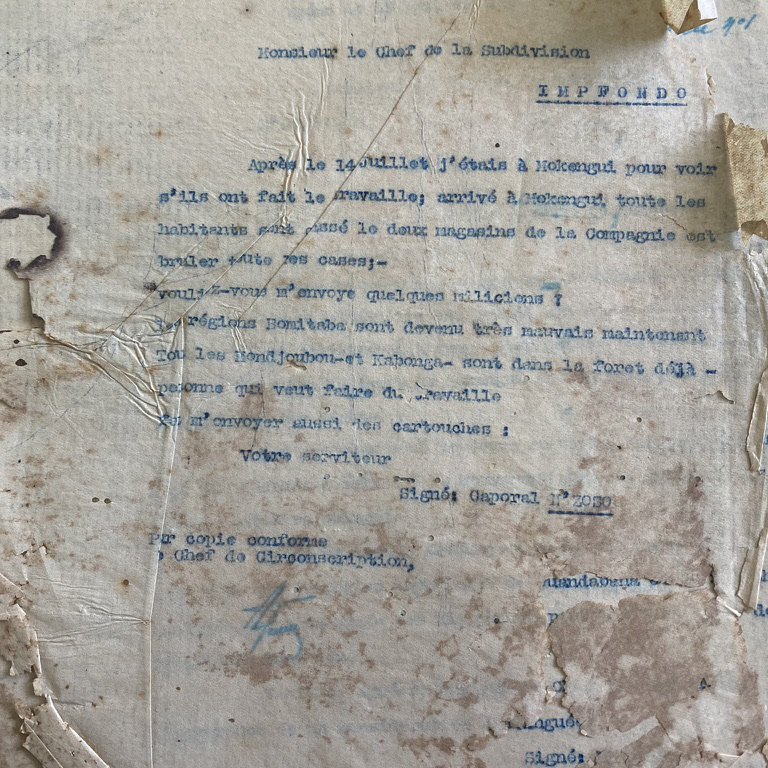 The archival component of this project was included to give historical depth to the ethnographic and ethnoprimatological components of the research. Recognizing the influence of the post-colonial setting in which we work in the Republic of Congo, Tiriel and I made preliminary visits to the National Archives in Brazzaville during our visits to the city during the 2022-2023 field period. There, we discovered a group of judicial notes and documents from the French colonial administration concerning where we work, the Likouala Department of the Republic of Congo. These documents provided us with insights into past non-local perceptions and management of this swamp-dominated landscape. However, the dearth of information there was also telling. To learn more, we have determined to more fully integrate archival research into our dissertations and hope to soon visit Aix-en-Provence where larger French colonial archives are located. We believe this kind of historical situating is important for all ecological and socio-ecological research. The origins of our academic disciplines (such as anthropology and primatology), as well as the construction of the landscapes we often work to understand or conserve, have deep colonial and imperial legacies which impact how and why we work upon them.
The archival component of this project was included to give historical depth to the ethnographic and ethnoprimatological components of the research. Recognizing the influence of the post-colonial setting in which we work in the Republic of Congo, Tiriel and I made preliminary visits to the National Archives in Brazzaville during our visits to the city during the 2022-2023 field period. There, we discovered a group of judicial notes and documents from the French colonial administration concerning where we work, the Likouala Department of the Republic of Congo. These documents provided us with insights into past non-local perceptions and management of this swamp-dominated landscape. However, the dearth of information there was also telling. To learn more, we have determined to more fully integrate archival research into our dissertations and hope to soon visit Aix-en-Provence where larger French colonial archives are located. We believe this kind of historical situating is important for all ecological and socio-ecological research. The origins of our academic disciplines (such as anthropology and primatology), as well as the construction of the landscapes we often work to understand or conserve, have deep colonial and imperial legacies which impact how and why we work upon them.
I am a part of a team of primate researchers working to highlight the ties between primatology and coloniality. To learn more about decolonizing primatology (and other academic disciplines), visit our website: https://primateeponyms.wixsite.com/eponyms
Or read our recent publication here





